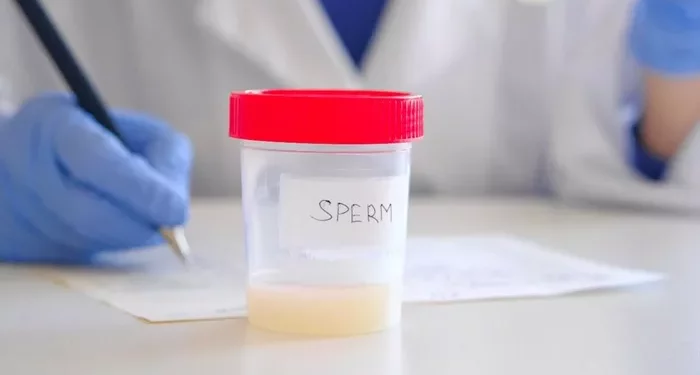When it comes to male reproductive health, many individuals encounter concerns regarding changes in the appearance of their ejaculate. One such common concern is the presence of a yellowish hue in semen. This condition, though often benign, can cause significant anxiety and confusion. Understanding why ejaculate might appear yellow is crucial in alleviating concerns and determining if medical attention is required. This article delves into the various causes of yellow ejaculate, providing a thorough exploration of potential reasons, associated symptoms, and when to seek professional advice.
See Also : Male Semen Analysis Test: A Guide to Checking Sperm Health
Normal Semen Characteristics
To understand the abnormalities, it is essential first to grasp what constitutes normal semen. Typically, semen is a whitish-gray fluid with a slightly viscous consistency. It is composed of sperm cells and seminal fluid, which is produced by various glands, including the seminal vesicles, prostate gland, and bulbourethral glands. The color, volume, and consistency of semen can vary depending on factors such as age, diet, and frequency of ejaculation.
Diet and Lifestyle Factors
Impact of Diet
The food and beverages consumed can significantly impact the color of ejaculate. For example, foods rich in sulfur, such as garlic and onions, can impart a yellowish tint to semen. Similarly, excessive consumption of certain vitamins, particularly vitamin B supplements, can result in yellow-colored ejaculate. This is due to the presence of riboflavin (vitamin B2), which is known to cause discoloration in bodily fluids.
Hydration Levels
Hydration levels play a crucial role in determining the color and consistency of semen. Dehydration can lead to more concentrated semen, which might appear darker or more yellow than usual. Ensuring adequate fluid intake can help maintain normal semen characteristics.
Tobacco and Alcohol Use
Smoking and excessive alcohol consumption can also influence semen color. The toxins present in cigarettes and alcoholic beverages can accumulate in the seminal fluid, leading to discoloration. Reducing or eliminating these substances from one’s lifestyle can improve overall reproductive health and potentially restore normal semen color.
Infections and Inflammatory Conditions
Sexually Transmitted Infections (STIs)
One of the primary medical concerns associated with yellow semen is the possibility of a sexually transmitted infection (STI). Infections such as gonorrhea and chlamydia can cause inflammation of the reproductive organs, leading to changes in semen color. These infections are typically accompanied by other symptoms, such as painful urination, genital discharge, and discomfort during ejaculation. If an STI is suspected, prompt medical evaluation and treatment are necessary.
Prostatitis
Prostatitis, or inflammation of the prostate gland, is another common condition that can cause yellow ejaculate. This condition can be bacterial or non-bacterial and may present with symptoms such as pelvic pain, difficulty urinating, and painful ejaculation. Chronic prostatitis, in particular, can lead to changes in semen color due to the presence of white blood cells and inflammatory debris in the seminal fluid.
Epididymitis
Epididymitis, the inflammation of the epididymis, is often caused by bacterial infections, including STIs and urinary tract infections. This condition can result in yellowish semen due to the presence of pus or blood in the ejaculate. Symptoms of epididymitis include scrotal pain, swelling, and tenderness, often necessitating antibiotic treatment.
Medical Conditions and Treatments
Jaundice
Jaundice, characterized by a yellowing of the skin and eyes due to elevated bilirubin levels, can also cause yellow semen. This condition is often related to liver disease, such as hepatitis or cirrhosis. When the liver is unable to effectively process bilirubin, it can accumulate in various bodily fluids, including semen.
Medications
Certain medications can affect the color of ejaculate. Antibiotics, such as metronidazole, and medications used to treat urinary tract infections, like nitrofurantoin, can cause a yellowish discoloration of semen. If a medication is suspected to be the cause, consulting a healthcare provider for possible alternatives or adjustments in dosage is advisable.
Chronic Health Conditions
Chronic health conditions, such as diabetes and kidney disease, can also influence the color of semen. These conditions can affect overall bodily function and fluid balance, potentially leading to changes in semen characteristics. Managing these underlying conditions with the help of a healthcare provider is crucial in maintaining reproductive health.
Aging and Semen Color
As men age, changes in semen color and consistency are not uncommon. The prostate gland may undergo changes that can influence the appearance of seminal fluid. Additionally, older men are more likely to experience chronic health conditions that can impact semen color. While age-related changes are often benign, persistent or concerning changes should be evaluated by a healthcare professional.
When to Seek Medical Advice
Not all instances of yellow semen indicate a serious health issue. However, certain signs warrant prompt medical attention. These include:
- Persistent yellow discoloration of semen
- Presence of blood or pus in the ejaculate
- Accompanying symptoms such as pain, swelling, or fever
- Changes in urinary habits or discomfort during urination
- Signs of a sexually transmitted infection, such as genital sores or discharge
A healthcare provider can conduct a thorough evaluation, which may include a physical examination, laboratory tests, and imaging studies, to determine the underlying cause and appropriate treatment.
Diagnostic Approaches
Physical Examination
A physical examination is often the first step in diagnosing the cause of yellow semen. The healthcare provider will assess the genital area for signs of infection, inflammation, or other abnormalities.
Laboratory Tests
Laboratory tests play a crucial role in diagnosing the cause of yellow semen. These tests may include:
- Semen analysis: This test evaluates the quality and characteristics of semen, including color, volume, and the presence of white blood cells or pathogens.
- Urinalysis: A urine test can detect signs of infection or other abnormalities that may be affecting semen color.
- Blood tests: Blood tests can assess overall health, including liver and kidney function, and screen for sexually transmitted infections.
Imaging Studies
In some cases, imaging studies such as ultrasound or MRI may be necessary to evaluate the prostate gland, epididymis, and other structures for signs of inflammation, infection, or other conditions that could affect semen color.
Treatment Options
The treatment for yellow semen depends on the underlying cause. Possible treatments include:
Antibiotics
If a bacterial infection is identified, antibiotics are the primary treatment. Conditions such as prostatitis, epididymitis, and certain sexually transmitted infections can be effectively treated with antibiotics. It is essential to complete the full course of antibiotics as prescribed to ensure the infection is fully eradicated.
Lifestyle Modifications
For cases where diet, hydration, or lifestyle factors are contributing to yellow semen, making appropriate modifications can help restore normal semen color. This may include:
- Increasing fluid intake to ensure proper hydration
- Reducing or eliminating the intake of foods and beverages that can cause discoloration
- Quitting smoking and reducing alcohol consumption
Management of Chronic Conditions
Managing underlying chronic health conditions, such as diabetes or liver disease, is crucial in addressing changes in semen color. Working with a healthcare provider to develop an effective treatment plan can help improve overall health and potentially resolve semen discoloration.
Regular Monitoring
In some cases, particularly when age-related changes or benign causes are suspected, regular monitoring may be recommended. Keeping track of any changes in semen color and associated symptoms can help in identifying patterns and determining if further evaluation is needed.
Preventive Measures
While not all causes of yellow semen can be prevented, certain measures can help maintain overall reproductive health and potentially reduce the risk of discoloration. These include:
- Practicing safe sex to prevent sexually transmitted infections
- Maintaining good hygiene to prevent infections
- Staying well-hydrated and consuming a balanced diet
- Avoiding excessive intake of supplements and medications without medical advice
- Regular medical check-ups to monitor and manage chronic health conditions
Conclusion
Yellow semen can be a source of concern, but understanding the various causes and associated symptoms can help in determining the appropriate course of action. While diet and lifestyle factors often play a significant role, infections, inflammatory conditions, and underlying health issues can also contribute to changes in semen color. Seeking medical advice when necessary and maintaining overall reproductive health through preventive measures are key in addressing this condition. By being informed and proactive, individuals can effectively manage their reproductive health and alleviate concerns related to yellow ejaculate.
Related Links:



























